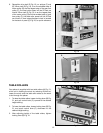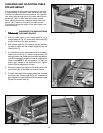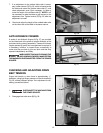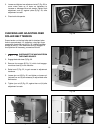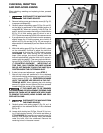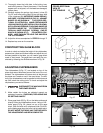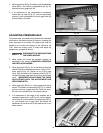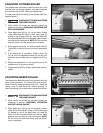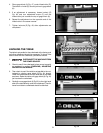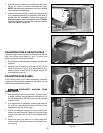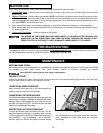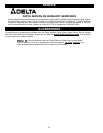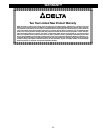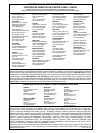
ADJUSTING TABLE GIBS
In the unlikely event of the table developing unwanted
movement during planing operations, the table can be
checked and adjusted as follows:
1. DISCONNECT MACHINE FROM
POWER SOURCE.
2. With the table in the locked position, and with a feel-
er gage, measure the gap between table gib (A) Fig.
54 and table bracket (B). When set correctly the gap
should be .005 .
3. If an adjustment is necessary, loosen three locknuts
(C), and turn three adjustment screws (D) Fig. 54, as
necessary to set the correct gap.
4. Check and adjust the gap on the other side of the
table in the same manner. Tighten six locknuts, three
of which are shown at (C) Fig. 54, after adjustment is
made.
5. Raise and lower the table to its fullest range and
check to see if the table moves up and down with-
out binding.
Fig. 53
A
B
Fig. 52
Fig. 51
C
E
B
D
ADJUSTING TABLE HEIGHT SCALE
The table height scale indicates the distance the table is
from the cutting circle (depth of cut). To check and
adjust the pointer, proceed as follows:
1. Run a piece of wood through the planer and stop the
machine.
2. Measure the thickness of the planed end of the
stock as shown in Fig. 52. If an adjustment is nec-
essary, loosen screw (A) Fig. 53, adjust pointer (B)
and retighten screw (A).
5. If the table is not parallel to the cutterhead, lower boot
(B) Fig. 51, which is located underneath the table.
NOTE: Table elevating handwheel must be unlocked
when making this adjustment.
6. Loosen lock screw (C) Fig. 51, and with large pliers (D)
turn adjustment sleeve (E) as necessary until table is
paralell with the cutterhead. Tighten lock screw (C)
after adjustment is made and replace boot (B). NOTE:
The same adjustment can also be made on the other
side of the planer if necessary.
Fig. 54
B
A
C
C
D
22



